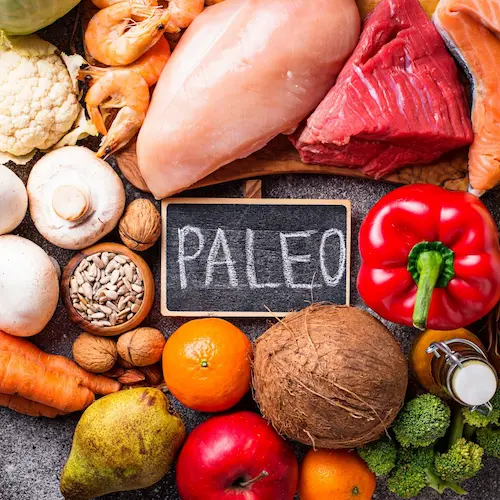The Paleo vs. Mediterranean diet: two diets that have grown in popularity as a promising guide to a healthier lifestyle and weight management. Which one reigns supreme? Let’s discuss the latest research so you can decide for yourself.

Mediterranean Diet Principles
The Mediterranean diet is based off of countries that surround the Mediterranean sea. It’s more of a lifestyle than a strict diet with rules!
While there is no specific definition of the Mediterranean diet, it typically consists of:
- Eating more fruits and vegetables
- Whole grains
- Healthy fats, specifically from olive oil
- Nuts, legumes, and seeds
- Lean protein, with a priority of consuming fish twice weekly
- Wine and dairy products, but consumed in low to moderate amounts

Mediterranean Diet Meal Plan Example
Breakfast: Eggs cooked in olive oil, served with veggies and oatmeal.
Lunch: Mediterranean grain bowl packed with veggies, nuts and quinoa.
Dinner: Salmon pan-fried in olive oil, served with 1/2 plate of roasted veggies and brown rice. One 6-ounce glass of wine.
What Does the Research Say?
The Mediterranean diet has received a lot of attention – and for good reason. It’s one of the most studied diets there is and has been associated with a wide range of healthy benefits.
Some of the benefits include:
— Decreased risk of cardiovascular disease and stroke.
— Lower risk of obesity, metabolic syndrome, hypertension and dyslipidemia.
— Improved glycemic control and lower risk of Type II diabetes.
— Less age-related cognitive dysfunction, particularly Alzheimer’s disease.
— Might help reduce inflammation, but further research needs to be done to better understand the relationship.
— May decrease risk of cancer, specifically breast cancer.
What Are the Cons of the Mediterranean Diet?
Like any diet, there are potential downsides to a Mediterranean lifestyle.
- With the focus on consuming fresh, non-processed foods, it can be time-consuming and more costly.
- There are no strict rules or guidelines, which can be confusing for some.
- There’s a small potential for iron deficiency if diet is not well-thought out as red meat is limited on this diet.
- You might gain weight with overconsumption of healthy fats and nuts.

Paleo Diet Principles
The Paleo diet is all about consuming foods eaten by early humans. Recommendations may vary, but it usually consists of eating:
- More fruits and vegetables
- Nuts and seeds
- Eggs
- Lean meats, especially grass-fed beef
- Fish, particularly those high in omega-3 fatty acids like salmon, tuna, and herring
- Oils from fruits and nuts, like olive oil and walnut oil

Example Paleo Diet Meal Plan
Note that the Paleo diet does not typically include dairy products, grains, legumes, or even starchy vegetables.
Breakfast: Scrambled eggs with a large bowl of fruit.
Lunch: Greek chicken salad.
Dinner: Lean beef steak with asparagus and mushrooms.
What Does the Research Say?
There is actually limited research examining the benefits of the Paleo diet, which is a vast difference when compared with the Mediterranean diet. Small studies have shown it might help with weight loss, blood pressure, triglycerides, and cholesterol.
How Does It Differ From the Mediterranean Diet?
The Paleo diet has more “rules” and states to avoid dairy products, grains, legumes, and starchy vegetables – which are foods that are included on a Mediterranean diet. The Paleolithic diet has been compared to a keto diet, as it is lower in carbohydrates.
What Are the Concerns of a Paleo Diet?
The Paleo diet has its’ fair share of concerns, some of them being:
— Elimination of specific food groups, like whole grains, legumes and dairy products. Because of this, there is more likely to be nutritional deficiencies since these food groups contain a large majority of vitamins and minerals.
— Without whole grains, it is harder to reach the recommended fiber intake.
— This diet is more expensive due to the focus being on lean protein sources and fresh fruit.
Related Posts:
The Main Differences
Both of these diets have the potential to promote weight loss and weight management, as the focus is on consuming more fruits and vegetables and less processed foods. However, the Paleo diet is much more restrictive with the potential to develop nutrient deficiencies.
There isn’t near as much evidence regarding the Paleo diet’s health benefits as there is for the Mediterranean diet. The Mediterranean diet has been widely-researched for many years, and has been proven to be beneficial to our health time and time again. However, according to one study- both diets could potentially decrease mortality risk.
There also aren’t specific “rules” for the Mediterranean diet – it’s more of developing a healthier lifestyle (which includes alcohol too!).
Both diets have the potential to be costly – with the Paleo diet being even less affordable due to the restriction of certain food groups.
Summary
As a dietitian who values evidence-based research, I can’t recommend the Mediterranean diet enough.
The jury is still out on the Paleo diet. I don’t love that it puts restrictions on specific food groups that can provide vital nutrients while also being affordable as well. However, I think that with careful planning – for example, consuming a wide variety of fruits, nuts and seeds – the potential for nutritional deficiencies is much lower.
Either way, both diets require a little more thought and planning when it comes to meals.
